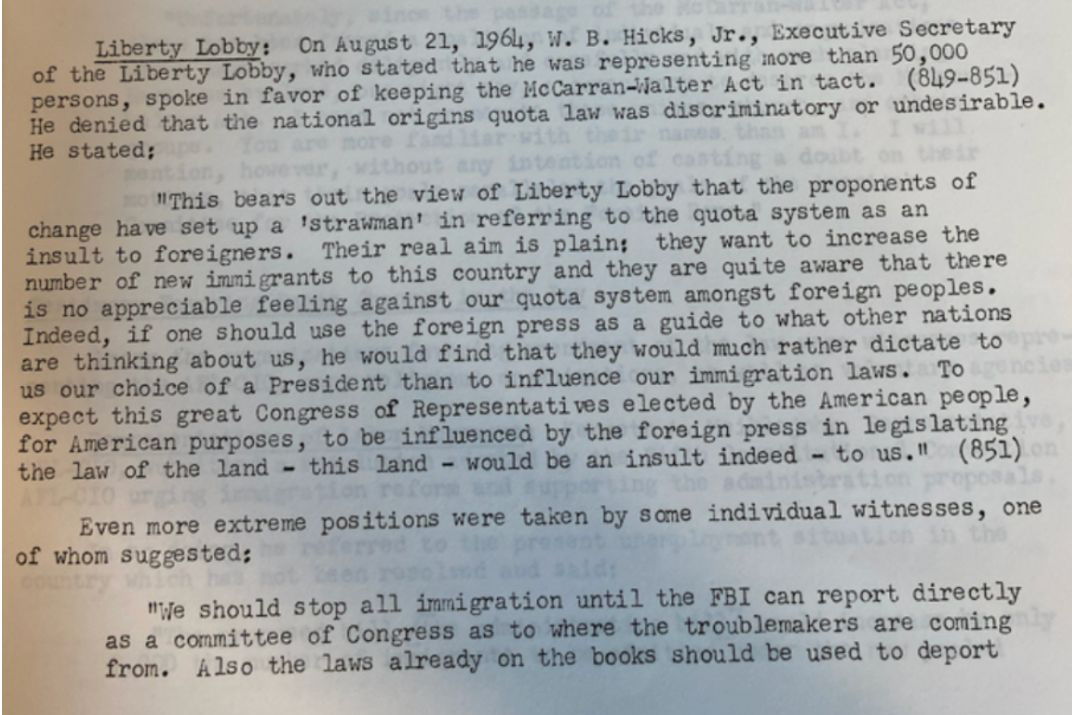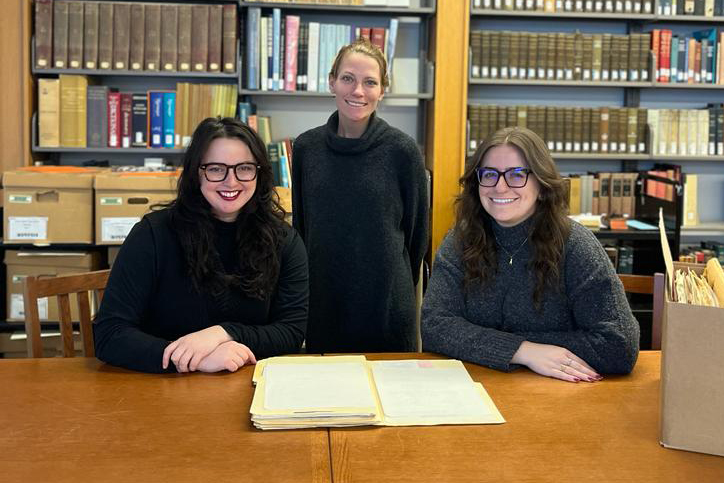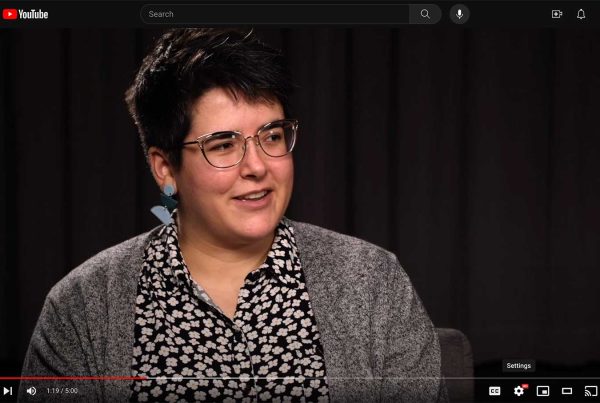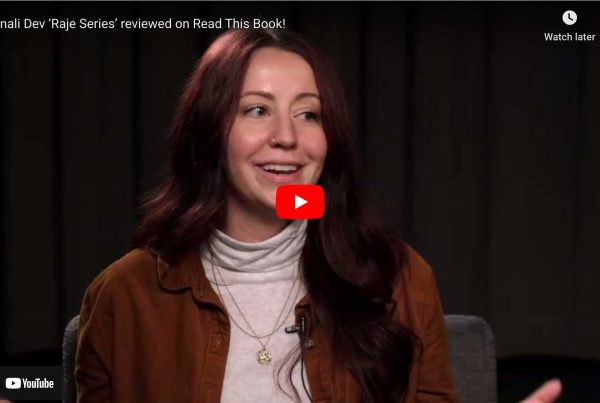Spotlight on Research: Guest authors and UMN graduate students Isabel Bethke, Nadia DelMedico, and Kimberly Horner researched for their first time in the Immigration History Research Center Archives (IHRCA) recently. They share their experiences with us in this blog post.
Introduction
In the summer of 2023, the Immigration History Research Center in the College of Liberal Arts welcomed its first cohort of summer graduate fellows, to research in the collections of the Immigration History Research Center Archives (IHRCA). The three University of Minnesota graduate student fellows came to this experience from different disciplines and with different academic interests. Isabel Bethke is a doctoral candidate in English and a juris doctoral student. She is interested in the narratives of migration and their implication on practical law. Nadia DelMedico is a doctoral student in art history, studying late 19th and early 20th century immigrant artists. Kimberly Horner is a doctoral candidate in public policy, and is focused on local governments’ efforts to incorporate immigrant communities in cities across the U.S. Despite disciplinary differences, this cohort holds in common an interest in the history of im/migration to the U.S. and a desire to learn about and engage in archival research.
Though each fellow arrived at the IHRCA with a research proposal and defined research question, the summer was largely shaped by experiences of surprises, dead ends, learning to read between the lines, adjusting to new ways of engaging with data, and the production of knowledge related to im/migration in the U.S. context. In the short anecdotes below, each fellow reflects on these experiences and how they shaped her research agenda and understanding of archival work as a methodological approach to im/migration scholarship. Across a range of new learnings – including the new insights on patterns and patience, new approaches such as beginning at the end, and ongoing reflexive engagement through broadening and focusing within the context of the archive – the summer represented a deeply meaningful opportunity to consider not just the research questions originally proposed, but the process through which researchers engage with and create im/migration knowledge.
Kim: On patterns and patience
When I arrived at the Elmer L. Andersen Library, home of the IHRCA, the archivist had prepared for me five boxes containing hundreds of documents; these were arranged on a cart in a silent reading room. Four boxes contained International Institute of Minnesota’s (IIM) Board of Directors meeting minutes, and the fifth box contained the Annual Reports. Feeling overwhelmed, I opened the first box, pulled out the Board of Directors minutes from 1931, and began to read.
My interest in the evolution of immigrant integration in the Twin Cities was what led me to this experience. My dissertation focuses on how municipal Offices of Immigrant and Refugee Affairs (OIRAs) support the integration of immigrant communities. However, most OIRAs were not established until the early 21st century. This includes the Minneapolis and St. Paul offices, established in 2018 and 2019, respectively. Working in the IHRCA was an opportunity to explore what integration looked like prior to the establishment of OIRAs.
The IIM is an organization that focuses on welcoming and supporting immigrants and refugees as they rebuild their lives in Minnesota. They have contributed one of the largest collections within the IHRCA. With over 200 boxes of materials, ranging from meeting minutes to newsletters to annual reports and individual case files, the collection provides an extensive look at immigration integration in the Twin Cities over the last century.
As I began exploring IIM materials, I tried different approaches to identifying meaningful patterns in specific document types. First, I looked at only meeting minutes. Then, I looked only at newsletters and annual reports. While searching for patterns over time, I was confronted by missing years, broad language, or the seemingly abrupt emergence and disappearance of threads I attempted to follow. Next I tried a more topical focus. Narrowing in on refugee resettlement in the late 20th century, I broadened the documents I explored to include casework materials, committee notes, administrative records, communications records, and daily call logs. It was interesting work, but it was incredibly frustrating. What was I missing? What patterns was I supposed to be finding?
After weeks of this cycle – tracing a pattern to its abrupt end and then searching for a new approach – it occurred to me that my frustration stemmed from my approach. I kept searching for continuity; I kept assuming I had failed when I found a dead end or abrupt turn.
What I came to realize was that not finding a consistent pattern was finding a consistent pattern: a pattern of responsive change. Clues were scattered throughout the materials: talk of new challenges, new programming, new strategies. In the Board of Director Meeting Minutes from 1982, board members noted that their “greatest responsibility [was] to the Institute and its future” – a priority that required “flexible and diverse” programming. Each time there were changes in funding or legislation, in populations arriving, or the concerns raised by the foreign-born or native-born communities, the IIM found a way to quickly pivot, respond, and continue. The IIM’s approach to integration, and the institution itself, made constant adjustments to remain sustainable and relevant in an ever-changing political, social, and demographic landscape. Through this strategy, the IIM has served immigrant and refugee communities in Minnesota for over 100 years and supported tens of thousands of individuals who have made Minnesota their new home.
My research in this area and my understanding of this responsive integration programming continues to evolve. My experience in the archives has opened new questions for me about the actors, policies, and relationships influencing local integration work, and their theoretical and practical implications for the wellbeing of immigrant and refugee communities. Essential to this work is patience – with the process, with the materials, and with myself as I learn to engage with the process of archival research.
Nadia: Beginning at the End
As an art historian, I’ve been trained to read images and objects as historical documents. The formal qualities, iconography, and subject matter of visual material serve as primary documentation of the social, political, economic, and personal histories of artists and ages. Visual media is the starting point in my research practice. A summer spent researching at the IHRCA required an inversion of this method and, in doing so, challenged, expanded, and diversified the research avenues I had planned to pursue.
I conducted exploratory research on the life and work of Onorio Ruotolo (1888-1966), an Italian immigrant who worked as a sculptor, printmaker, poet, and educator in New York after migrating to the United States in 1908. With his founding partner and fellow Italian migrant Attilio Piccirilli (1866-1945), Ruotolo launched the careers of several preeminent first and second generation immigrant artists, including painters Nicolas Carone (1917-2010) and Elaine de Kooning (1918-1989), sculptor Peter Agostini (1913-1993), and landscape artist Isamu Noguchi (1904-1988). Not only were these students prolific in their own right, but artists like Carone and de Kooning were foundational to the development of Abstract Expressionism, widely regarded as the foremost uniquely American modern art movement and a catalyst for the art world’s geographical shift from Paris to New York City.
This project was proposed as exploratory work; while I knew that I would find six Hollinger boxes waiting for me in the Andersen Library reading room, I had little clarity on what exactly constituted the collection of Ruotolo’s personal papers which also includes his records of the Leonardo da Vinci Art School. With no image or object to anchor my reading, I slowly and meticulously took notes on everything, not knowing what could ultimately be a smoking gun and what was just another letter soliciting funding.
This led me to a wealth of information that I continue to synthesize and research further. Some of this information was expected: copies of his poems and letters from colleagues praising his writing; minutes from the Leonardo da Vinci Art School’s board meetings; and advertising materials including pamphlets and business cards. Others were surprising: letters from Lokanatha, a Buddhist missionary leading conversion efforts in the United States (and Ruotolo’s cousin); poem of adoration and letters expressing admiration for Helen Keller and her teacher, Anne Sullivan; and letters to Fiorello La Guardia, Mayor of New York City, offering the specifications for an invention of an anti-aircraft missile. (A cheeky reply reminds Ruotolo that La Guardia has no control over the Army or Navy, but to please send any solutions he may have for trash and sanitation in the city).
While these threads have yet to be woven together into a clear narrative, we have much to learn from Ruotolo’s story as it exists in this archive. There are many stories to be told and questions to be asked when we consider the textual archive alongside the visual: How did immigrant artists balance the business and creative practice of artmaking? How did artmaking simultaneously facilitate assimilation and cultural preservation? How did immigrant artists shape the “American” art world? What is the legacy of immigrant artists as educators?
While I continue my work in the archive and begin to synthesize this information with his oeuvre, the narrative possibilities continue to multiply for me. Reframing my art historical practice to begin with the textual instead of the visual not only highlighted new aspects of Ruotolo’s artmaking process, such as the financial, social, and bureaucratic obligations of an artist and educator, but also complicated my reading of his artworks.
Isabel: On Broadening and Focusing
As an English and Legal scholar, archival research has never been at the forefront of my work. While primary documents may play a role in my understanding of legal narratives, especially the law itself, the statutes and other enforced doctrine are largely available online. Therefore, when entering the IHRCA, my goal was to prove a hypothesis I had already posited: the processes of legislation play a significant role in the creation and perpetuation of narrative stereotypes. Specifically, I aimed to find evidence that racist stereotypes were embedded in the Immigration and Nationality Act (INA) amendments in the 1960s leading to the 1967 adoption of the UN’s Refugee Protocol.
After consultation with Archivist Daniel Necas, we decided that the Interpreter Releases would be the best option for understanding the shifts in immigration law during a limited period (1960-1969). The Interpreter Releases began as a publication in 1923 by the Foreign Language and Information Service. This Service later became the American Council for Nationalities Services. The goal of these Releases were to provide information on immigration law to immigration attorneys, social workers, service organizations, and other interested parties.
When initially learning of this collection, I had little knowledge of the Interpreter Releases. Their title, “Interpreter Releases” did little to reveal their contents to me, and it was not until I began working with the Releases that I understood their historical role in immigration studies and dissemination of immigration law. As always with texts in the archive, I was curious to see these releases in action: What was their actual use at the time they were circulated?
I decided to begin with the Releases from 1964, as this year prefaces significant amendments to the INA in 1965, and adoption of the UN’s Refugee Protocol in 1967. Upon initial review, the documents in this section largely confirmed my working hypothesis that government employees and witnesses appearing before Congress communicated using harmful stereotypes.
The excerpt below is from a report on the House hearings on public response to pending immigration legislation. The witnesses, both named and unnamed, use xenophobic language, specifically, “We should stop all immigration until the FBI can report directly as a committee of Congress as to where the troublemakers are coming from.” This language resembles the 2023-24 congressional landscape, where debates over immigration are still largely driven by unsupported discriminatory claims. For me, this language reveals a section of public opinion, though it does not prove governmental reaction. However, this rhetoric is mirrored in today’s Congress and yet partisan rifts have kept immigration reform at a standstill.
For example, during a February 2023 hearing, Rep. Jimmy Gomez (D-Calif.) indicated that, “This hearing isn’t about border security or solving our opioid crisis. It isn’t even facts. What it’s about is painting immigrants as villains in order for my colleagues to further their anti-immigrant agenda.” Using narrative theory to track the progression of the language of immigration over time, these comparisons between 1964 and 2023 can be visualized as somewhat of a flat line: fear tactics are employed regularly as well as statistically uninformed statements.

Interpreter Releases Vol. 41, No. 47. December 14, 1964. Edith Lowenstein, Editor. “House Hearings on Pending Immigration Legislation IV.” Immigration and Refugee Services of America Records, IHRCA, University of Minnesota Libraries.
One of the difficulties of coming across the “smoking gun” of archival evidence is to not ignore the context in which this evidence is found. Just two pages after the above excerpt, a quote from a House representative affirmed immigrant skills as the cornerstone of the American economy. From this contradictory moment, I realized that the clear focus I had going into the archive was misguided. As an archive-research neophyte, I learned from this experience that when faced with what appears to be an endless supply of materials, entering in with a broad research question is somewhat essential. The broader the question, the more opportunity for a guided narrowing in accordance with the materials.
An additional challenge was in finding the right speed at which to travel through the Releases. Initially, I was transcribing nearly everything I found. This proved to be limiting, as it restricted my time and did not help me to either expand or narrow my research interests. Through the fellowship, I came to the conclusion that this broadening and narrowing of scope may be innate to archival research, which should be celebrated as a process instead of only a conclusion. The evolution of my own research within the archive will oscillate between breadth and depth, an exercise I can appreciate for its additions to my research, as well as for the experience itself.
Conclusion
As explained in their own reflections, the 2023 Immigration History Research Center Summer Graduate Fellows found great inspiration in both the content and processes of their archival research. In addition to gaining this invaluable hands-on archival experience, the fellows benefited from the community they gained with the Immigration History Research Center, the IHRCA archivists, and each other. Each fellow plans to continue her work with archives, both formally and informally, and looks forward to speaking with potential researchers about her findings. Their collaborative paper emerging from these experiences was recently accepted to the Law and Society Annual Conference being held in Denver, Colorado, this June. For more information on the Immigration History Research Center Summer Graduate Fellowship, contact Michele Waslin at waslin@umn.edu.





